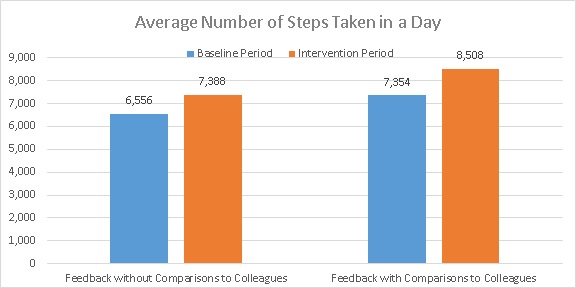
Out-Walking the Joneses
Organization : Center for Health Incentives and Behavioral Economics
Project Overview
Project Summary
Staff members received feedback comparing their daily walking behavior to that of their colleagues.
Impact
Staff members who received feedback about how their step-counts compared to those of their colleagues took 1,120 more steps per day than those who were only able to monitor their own step-count.
Challenge
The use of technologies like pedometers to track daily step counts has become an especially popular way for individuals to improve their exercise habits, but simply giving people feedback on their own exercise behavior may not be the most effective method. By applying insights from the behavioral sciences, we can optimize the design of self-monitors and enhance their potential effectiveness.
Design

Employees were shown messages comparing the number of steps they took to the number of steps taken by colleagues
Participants in the treatment group received feedback comparing their walking behavior to that of their colleagues. Participants in a comparison group simply tracked their own steps and tried to increase their daily totals. All the participants completed a daily weblog of their walking, but those in the treatment group saw an additional message letting them know whether they walked more or less than the other participants. They also received two e-mails per week with similar comparisons.
Impact

A randomized evaluation found that staff members who received feedback about how their step-counts compared to those of their colleagues walked 1,120 more steps per day than those who were only able to monitor their own step-counts, without any information about the step-counts of others.
Providing social comparisons increased step-counts whether staff members were told that they had been walking more or less than their colleagues.
Implementation Guidelines
Inspired to implement this design in your own work? Here are some things to think about before you get started:
- Are the behavioral drivers to the problem you are trying to solve similar to the ones described in the challenge section of this project?
- Is it feasible to adapt the design to address your problem?
- Could there be structural barriers at play that might keep the design from having the desired effect?
- Finally, we encourage you to make sure you monitor, test and take steps to iterate on designs often when either adapting them to a new context or scaling up to make sure they’re effective.
Additionally, consider the following insights from the design’s researcher:
- Adding a leaderboard to existing self-monitoring products that allows for social comparisons could motivate people to exercise more.
Project Credits
Researchers:
Gretchen Chapman Contact Rutgers University
Helen Colby Indiana University
Kimberly Convery Rutgers University
Elliot Coups Rutgers University


